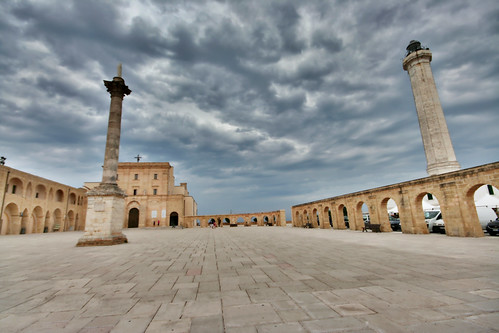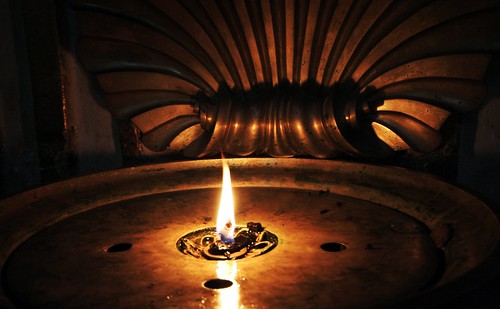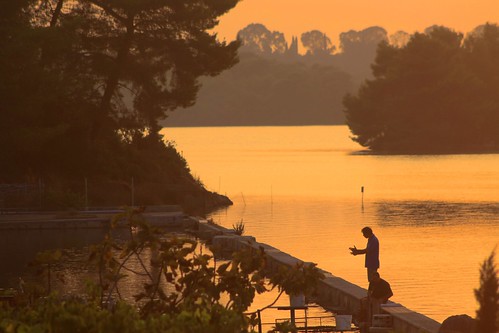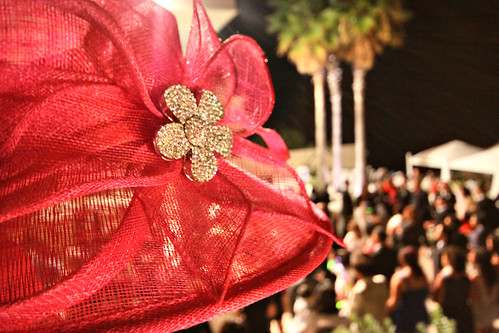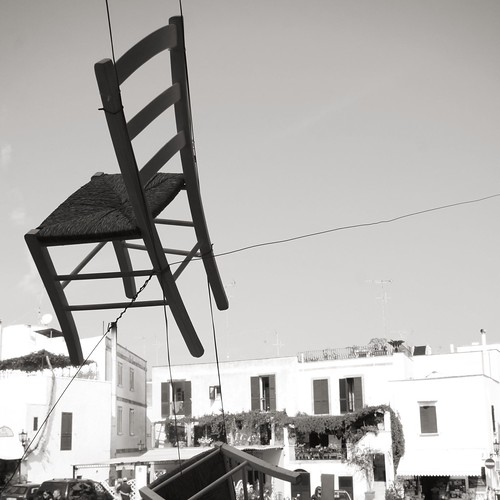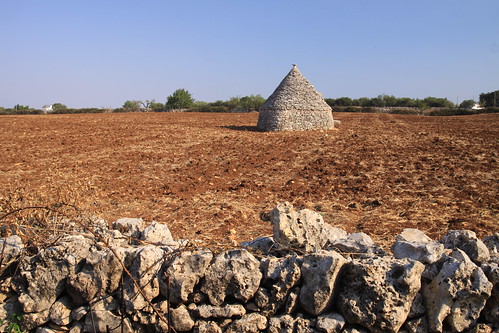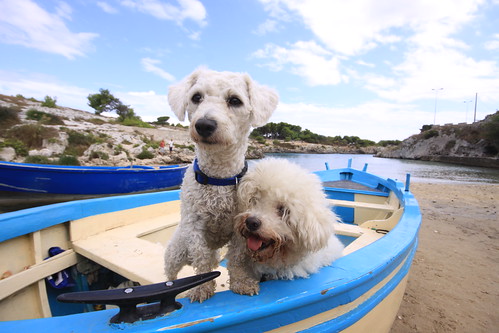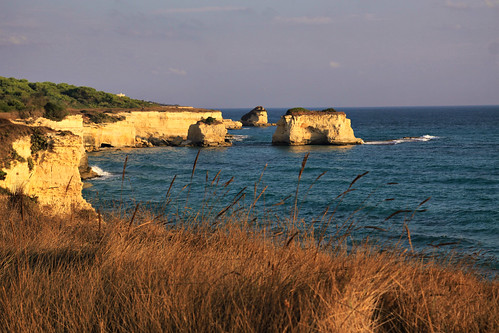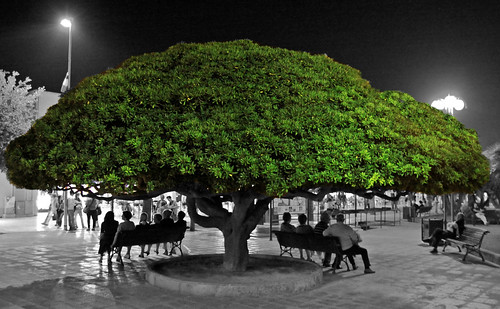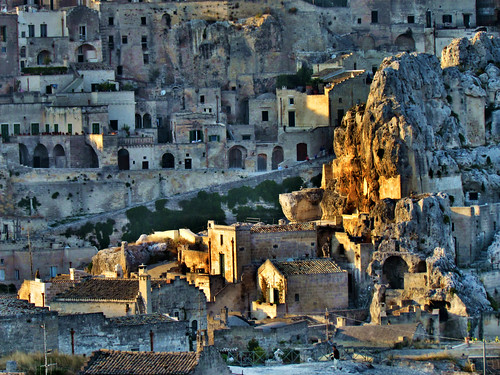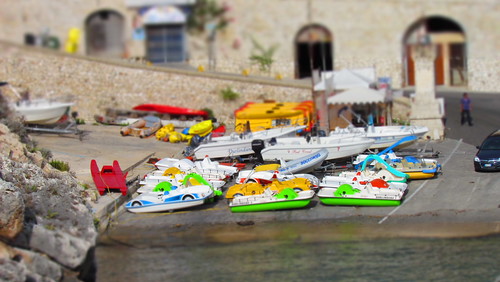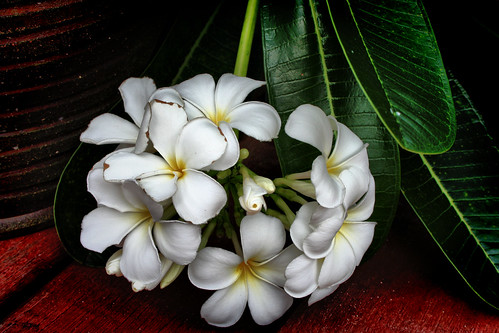24 October, 2011
23 October, 2011
Leuca | Finibus Terrae
© Angela M. Lobefaro
All Rights Reserved
RIPRODUZIONE RISERVATA
taken in Santa Maria di Leuca, Italy
Basilica Santa Maria De Finibus Terrae
La data virtuale che ha dato inizio al culto cristiano sul promontorio japigeo nell'attuale Basilica di Leuca deve collocarsi ai tempi di San Pietro. Si tramanda che San Pietro in viaggio per Roma fece tappa a Leuca e da allora il tempio dedicato alla dea Minerva, posto sul promontorio japigeo, diventò un luogo di culto cristiano. La devozione dei fedeli verso la Madonna di Leuca ha origine antica: si parla di un grande miracolo che avrebbe salvato i pescatori il 13 aprile 365 da una burrasca. La chiesa con l'attuale struttura fortificata, fu costruita tra il 1720 ed il 1755 da monsignor Giovanni Giannelli, per resistere ai numerosi e ripetuti attacchi da parte di invasori turchi e saraceni. L'interno del Santuario è ad unica navata e sull'altare maggiore si può ammirare il dipinto della Madonna con Bambino (Madonna De Finibus Terrae) di Jacopo Palma il Giovane. Arricchiscono l'interno della chiesa sei altari, ai lati della navata, un organo da poco restaurato e datato 1885 e numerosi dipinti, tra cui spiccano quelli del pittore Francesco Saverio Mercaldi (il San Francesco da Paola datato 1898 e il Trittico della Confessione). Dal 7 ottobre 1990 il Santuario è stato eletto a Basilica minore ed il numero di visitatori e devoti è notevolmente aumentato. Nel 2000, celebrazione dell'Anno Santo, sono stati eseguiti importanti lavori di restauro ed i vecchi portoni d'ingresso sono stati sostituiti con portoni in bronzo, opera dello scultore Armando Marrocco. Questi i nomi delle tre porte: Janua Coeli (centrale) – Esodo (destra) – Stella Maris (sinistra). Sempre dal 2000 il complesso del Santuario si è arricchito di una vasta sala per conferenze ed un museo che attualmente ospita opere di importanti artisti contemporanei. All'interno della chiesa, sul lato destro dell'ingresso, troviamo un grosso masso monolitico, l'Ara a Minerva, testimonianza dell'antico culto che si teneva alla dea Minerva. Sempre all'ingresso ma questa volta sul lato sinistro, è posta una targa in bronzo a commemorazione dell'equipaggio dell'incrociatore francese Léon Gambetta, affondato a largo di Leuca la notte del 26 aprile 1915 con circa 700 uomini. Nel piazzale antistante la Basilica, rivolta verso la marina del paese, sorge la Croce monumentale, eretta il 21 ottobre 1901 in occasione dell'Anno Santo. Presenta quattro iscrizioni sui lati della costruzione. Sul viale che conduce alla Basilica tra gli alberi della pineta, si trova la Croce Pietrina costruita a testimonianza del passaggio di San Pietro. Infine molto famosa è la scalinata della cascata monumentale, ovvero due rampe di scale ognuna di 300 gradini che collegano il Santuario con il porto vecchio. Vennero costruite nel periodo fascista in occasione delle opere terminali dell'Acquedotto. Le due scalinate sono separate da una cascata artificiale aperta solo in occasioni particolari. A piedi delle scale si eleva la colonna romana del 1939.
La chiesa di Cristo Re
Chiesa di Cristo Re [modifica]
Si trova nel centro della marina di Leuca. I lavori di costruzione iniziarono nel 1896 su progetto dell'ingegnere Pasquale Ruggeri. L'apertura ai fedeli ed al pubblico avvenne però, solo 40 anni dopo nel 1935. Realizzata in carparo, è in stile romanico e gotico. L'interno si divide in tre navate. Molto bello il pavimento in mosaico, completato nel 1934,ed il rosone della facciata principale. I grandi finestroni delle navate laterali recano i nomi e gli stemmi delle famiglie nobili che parteciparono alla costruzione della chiesa.
it.wikipedia.org/wiki/Santa_Maria_di_Leuca#Basilica_Santa...
Posted by
Angela Lobefaro
at
11:20:00 AM
0
comments
![]()
22 October, 2011
Keep the Faith | Salento Edition
© Angela M. Lobefaro
All Rights Reserved
RIPRODUZIONE RISERVATA
taken in Lecce, Italy
Lecce (Italian: [ˈlettʃe] ( listen), Griko: Luppìu, Ancient Greek: Ἀλήσιον) is a historic city of 95,200 inhabitants in southern Italy, the capital of the province of Lecce, the second province in the region by population, as well as one of the most important cities of Puglia. It is the main city of the Salentine Peninsula, a sub-peninsula at the heel of the Italian Peninsula and is over 2,000 years old.
Because of the rich Baroque architectural monuments found in the city, Lecce is commonly nicknamed[2] "The Florence of the South". The city also has a long traditional affinity with Greek culture going back to its foundation; the Messapii who founded the city are said to have been Cretans in Greek records.[3] To this day, in the Grecìa Salentina, a group of towns not far from Lecce, the griko language is still spoken.
In terms of industry the "Lecce stone" is the city's main export, because it is very soft and malleable, thus suitable for sculptures. Lecce stone is a kind of limestone.[4] Lecce is also an important agricultural centre, chiefly for its olive oil and wine production, as well as an industrial centre specialising in ceramic production.
en.wikipedia.org/wiki/Lecce
Posted by
Angela Lobefaro
at
10:13:00 PM
0
comments
![]()
20 October, 2011
Fishing Tales | Salento edition
© Angela M. Lobefaro
All Rights Reserved
RIPRODUZIONE RISERVATA
My Popular-Interesting Photos on Flickriver
taken near Otranto
Puglia - Italy
Otranto (Italian pronunciation: [ˈɔːtranto]) is a town and comune in the province of Lecce (Apulia, Italy), in a fertile region once famous for its breed of horses.
It is located on the east coast of the Salento peninsula. The Strait of Otranto, to which the city gives its name, connects the Adriatic Sea with the Ionian Sea and Italy with Albania. The harbour is small and has little trade.
The lighthouse Faro della Palascìa, at approximately 5 km southeast of Otranto, marks the most easterly point of the Italian mainland.
About 50 km south lies the promontory of Santa Maria di Leuca (so called since ancient times from its white cliffs, leukos being Greek for white), the southeastern extremity of Italy, the ancient Promontorium lapygium or Sallentinum. The district between this promontory and Otranto is thickly populated and very fertile.
en.wikipedia.org/wiki/Otranto
Posted by
Angela Lobefaro
at
11:01:00 PM
0
comments
![]()
19 October, 2011
16 October, 2011
Leaning toward Tomorrow | Domani é un altro Giorno

Leaning toward Tomorrow | Domani é un altro Giorno, originally uploaded by ! . © Angela Lobefaro . !.
ko yao noi, thailand
Posted by
Angela Lobefaro
at
2:27:00 PM
0
comments
![]()
The Wedding | Fine della Festa
taken during a wedding, in Giovanazzo. Apulia. Italy
Posted by
Angela Lobefaro
at
12:10:00 PM
0
comments
![]()
15 October, 2011
Occupy this | Python edition
© Angela M. Lobefaro
All Rights Reserved
RIPRODUZIONE RISERVATA
taken in Otranto. Italy
The Zen of Python
Beautiful is better than ugly.
Explicit is better than implicit.
Simple is better than complex.
Complex is better than complicated.
Flat is better than nested.
Sparse is better than dense.
Readability counts.
Special cases aren't special enough to break the rules.
Although practicality beats purity.
Errors should never pass silently.
Unless explicitly silenced.
In the face of ambiguity, refuse the temptation to guess.
There should be one-- and preferably only one --obvious way to do it.
Although that way may not be obvious at first unless you're Dutch.
Now is better than never.
Although never is often better than *right* now.
If the implementation is hard to explain, it's a bad idea.
If the implementation is easy to explain, it may be a good idea.
Namespaces are one honking great idea -- let's do more of those!
Posted by
Angela Lobefaro
at
2:19:00 PM
0
comments
![]()
Masseria Lobefaro
view from Masseria Lobefaro:
NO, I did NOT inherited even a stone...a dish .. a fourniture.
Posted by
Angela Lobefaro
at
2:18:00 AM
0
comments
![]()
13 October, 2011
Pirates | Porto Badisco
© Angela M. Lobefaro
All Rights Reserved
RIPRODUZIONE RISERVATA
taken in Porto Badisco, Otranto. Italy
description Courtesy of Wikipedia
en.wikipedia.org/wiki/Otranto
« Dove due rocce spumeggiano d'acqua salata,
mentre il porto rimane nascosto. »
(Virgilio, Eneide (III, 552))
Porto Badisco è una nota località balneare situata nel territorio del comune di Otranto, in provincia di Lecce.
Meta turistica di notevole interesse storico-paesaggistico, si affaccia sul mar Adriatico[1] e dista meno di 8 km da Otranto, 37 km da Lecce, 8 km da Santa Cesarea Terme e 15 km da Castro.
Indice
[nascondi]
1 L'approdo di Enea in Italia
2 La Grotta dei Cervi
3 Il Parco Regionale
4 Note
5 Voci correlate
6 Collegamenti esterni
L'approdo di Enea in Italia [modifica]
Secondo un'interpretazione ricorrente fu Badisco il primo approdo di Enea, descritto nell'Eneide di Virgilio: l'eroe vi avrebbe fatto scalo nel suo viaggio in Italia dopo la fuga da Troia (studi recenti hanno evidenziato tuttavia che Virgilio avrebbe più probabilmente immaginato tale sbarco nei pressi di Roca Vecchia, punto d'approdo di una rotta molto frequentata nell'antichità, oppure a Castro Marina, dove sono stati rinvenuti i resti di un tempio dedicato a Minerva).
La Grotta dei Cervi [modifica]
A Porto Badisco si trova inoltre la Grotta dei Cervi, che contiene importanti disegni realizzati con guano di pipistrello Neolitici ed è caratterizzata da numerosi anfratti e calette di rara bellezza. In Direzione Santa Cesarea-Castro-Leuca, inoltre, si trova la cosiddetta "Grotta delle Striare", cioè grotta delle streghe, caratteristica per l'entrata attraversata in diagonale da una lingua di roccia.
Il Parco Regionale [modifica]
Dall'ottobre 2006 parte del territorio di Otranto rientra nel Parco della costa di Otranto-Santa Maria di Leuca e del bosco di Tricase, istituito dalla Regione Puglia allo scopo di salvaguardare la costa orientale del Salento, ricca di pregiati beni architettonici e di importanti specie animali e vegetali.
Posted by
Angela Lobefaro
at
9:57:00 PM
0
comments
![]()
12 October, 2011
Captains Corageous | San Foca edition
© Angela M. Lobefaro
All Rights Reserved
RIPRODUZIONE RISERVATA
Taken near Otranto,
Puglia - Italy
Salento.
Salento (Salentu in local dialect) is the south-eastern extremity of the Apulia region of Italy. It is a sub-peninsula of the main Italian peninsula, sometimes described as the "heel" of the Italian "boot". It encompasses the entire administrative area of the province of Lecce, a large part of the administrative area of Brindisi and part of that of Taranto. The peninsula is also known as Terra d'Otranto, and in ancient times was called variously Messapia, Calabria, and Salentina.
Contents
History
Messapia (from Greek Μεσσαπία) was the ancient name of a region of Italy largely corresponding to modern Salento. It was inhabited chiefly by the Messapii in classical times. Pokorny derives the toponym from PIE *medhyo-, "middle" and PIE *ap-, "water" (Mess-apia, "amid waters"; Note: the asterisk before a word indicates that it is a hypothetical construction, not an attested form). Pokorny compares the toponym Messapia to another ancient Italic toponym, Salapia, "salt water", a city in Apulia.
Salento peninsula is a rock of limestone dividing the Adriatic Sea from the Ionian Sea. Known also as "peninsula salentina", from a geo-morphologic point of view it encompasses the land borders between Ionian sea and the Adriatic sea to the “Messapic threshold”, a depression that runs along the Taranto-Ostuni line and separates it from the Murge. Its borders are:
Taranto, in the province of the same name;
Pilone, in the territory of Ostuni (province of Brindisi),
Santa Maria di Leuca, in the province of Lecce.
Courtesy of Wikipedia, the free encyclopedia
Posted by
Angela Lobefaro
at
8:56:00 PM
0
comments
![]()
10 October, 2011
The Jurors | Otranto edition
© Angela M. Lobefaro
All Rights Reserved
RIPRODUZIONE RISERVATA
taken in Otranto
Puglia - Italy
Otranto (Italian pronunciation: [ˈɔːtranto]) is a town and comune in the province of Lecce (Apulia, Italy), in a fertile region once famous for its breed of horses.
It is located on the east coast of the Salento peninsula. The Strait of Otranto, to which the city gives its name, connects the Adriatic Sea with the Ionian Sea and Italy with Albania. The harbour is small and has little trade.
The lighthouse Faro della Palascìa, at approximately 5 km southeast of Otranto, marks the most easterly point of the Italian mainland.
About 50 km south lies the promontory of Santa Maria di Leuca (so called since ancient times from its white cliffs, leukos being Greek for white), the southeastern extremity of Italy, the ancient Promontorium lapygium or Sallentinum. The district between this promontory and Otranto is thickly populated and very fertile.
en.wikipedia.org/wiki/Otranto
Posted by
Angela Lobefaro
at
6:49:00 PM
0
comments
![]()
08 October, 2011
Matera's Heart of Stone
© Angela M. Lobefaro
All Rights Reserved
RIPRODUZIONE RISERVATA
taken in Matera
Basilicata - Italy
Matera has gained international fame for its ancient town, the "Sassi di Matera" (meaning "stones of Matera"). The Sassi originate from a prehistoric (troglodyte) settlement, and are suspected to be some of the first human settlements in Italy. The Sassi are houses dug into the calcareous rock itself, which is characteristic of Basilicata and Apulia. Many of these "houses" are really only caverns, and the streets in some parts of the Sassi often are located on the rooftops of other houses. The ancient town grew in height on one slope of the ravine created by a river that is now a small stream. The ravine is known locally as "la Gravina". In the 1950s, the government of Italy forcefully relocated most of the population of the Sassi to areas of the developing modern city. However, people continued to live in the Sassi, and according to the English Fodor's guide:
“ Matera is the only place in the world where people can boast to be still living in the same houses of their ancestors of 9,000 years ago. ”
Until the late 1980s this was considered an area of poverty, since these houses were, and in most areas still are, mostly unlivable. Current local administration, however, has become more tourism-oriented, and has promoted the re-generation of the Sassi with the aid of the European Union, the government, UNESCO, and Hollywood. Today there are many thriving businesses, pubs, and hotels.
en.wikipedia.org/wiki/Matera
Posted by
Angela Lobefaro
at
7:48:00 AM
0
comments
![]()
07 October, 2011
End of Summer | Castro Marina
© Angela M. Lobefaro
All Rights Reserved
RIPRODUZIONE RISERVATA
taken in Castro Marina
Puglia - Italy
Posted by
Angela Lobefaro
at
8:40:00 PM
0
comments
![]()
06 October, 2011
R.I.P. Steve Jobs
Tribute to Steve Jobs.
I always liked his innovative products, pity I could not afford them.
.
Posted by
Angela Lobefaro
at
5:37:00 PM
0
comments
![]()
05 October, 2011
Idea's Rollercoaster
© Angela M. Lobefaro
All Rights Reserved
RIPRODUZIONE RISERVATA
taken in Santa Cesarea Terme
Puglia - Italy
Posted by
Angela Lobefaro
at
9:40:00 PM
0
comments
![]()
Golden Shower over Mist and Olive Trees
© Angela M. Lobefaro
All Rights Reserved
RIPRODUZIONE RISERVATA
taken on the road between Otranto and Martano
Puglia - Italy
Posted by
Angela Lobefaro
at
4:57:00 PM
0
comments
![]()

